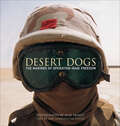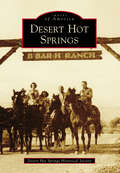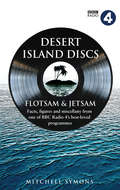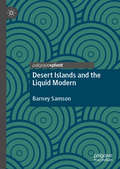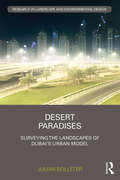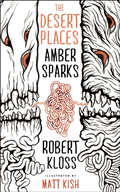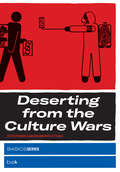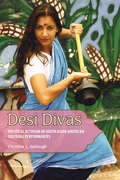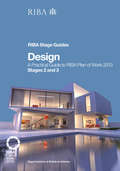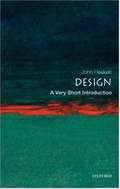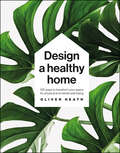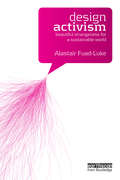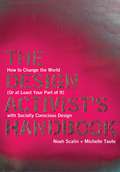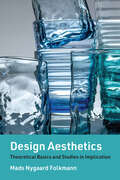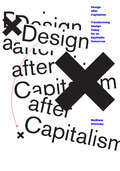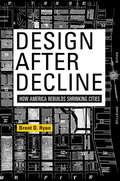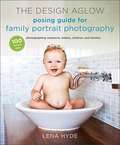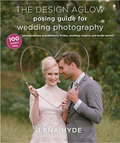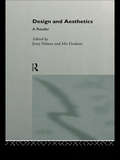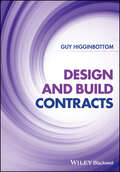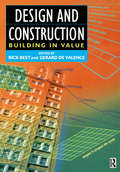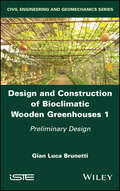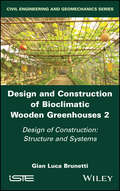- Table View
- List View
Desert Dogs: The Marines of Operation Iraqi Freedom
by Russ Bryant Amy Goodpaster StrebeA photographic account that highlights the human side of war, the day-in-the-life of US Marines stationed in Iraq.Desert Dogs includes dramatic, harrowing, and simply unbelievable images of the marines of Operation Iraqi Freedom, personal letters, and stories of coping with the pain of separation from their families and the horrors of war. Russ Bryant’s photography chronicles every aspect of the daily lives of these marines: lazy camels amble by a cargo drop; blinding sandstorms threaten to blow away tents, supplies, and marines alike; Scud missile attack sirens send marines scuttling to their bunkers; sniper fire crisscrosses marine convoys moving into Iraq; tanks and bombs topple the portraits of Saddam that seem to loom over every Iraqi village; shelled-out tanks, armored vehicles, and even busses litter the road on the way to Baghdad; medical personnel attend to fallen marines and prisoners alike; the occasional silent interlude allows time for prayer and remembrance.
Desert Hot Springs
by Desert Hot Springs Historical SocietyCabot Yerxa's discovery of natural hot and cold mineral water in 1914 was the impetus for the establishment of Desert Hot Springs. His eccentric pueblo-style home, which is listed in the National Register of Historic Places, is a unique tourist attraction. L.W. Coffee also recognized the value of the hot water, so he drilled wells and opened his famous bathhouse in 1941. The development of more than 200 spas followed. Angel View Children's Hospital, established in the 1950s, uses the therapeutic water to treat disabled children. The city's extraordinary, pure cold water wins awards such as "best tasting in the world." Desert Hot Springs is the location of architect John Lautner's first desert commission, and Mary Pickford's house still stands at the famous B-Bar-H Ranch that was frequented by movie stars during the 1940s and 1950s. The historic Two Bunch Palms Resort and Spa is known as an exclusive celebrity hideaway. The city, believed to have an unusually strong vortex, is located just south of Joshua Tree National Park. An elevation of 1,200 feet affords most residents magnificent views of both Mount San Jacinto and Mount San Gorgonio.
Desert Island Discs: Fascinating facts, figures and miscellany from one of BBC Radio 4’s best-loved programmes
by Mitchell SymonsFlotsam & Jetsam is the ultimate trivia book for fans of the popular BBC Radio 4 programme Desert Island Discs, and a fascinating introduction for all those who have yet to discover its delights.Taking the reader through seven decades of wonderful entertainment, here is an absorbing range of facts, figures and miscellany – including who chose what, and why. It also reveals much about the castaways' drives and motivations, their influences and, of course, their lives.Spanning the early years with the original presenter, Roy Plomley, and the present day, the Desert Island Discs programme has brought its own unique surprises to listeners, some very personal, some humorous, such as Eric Morecambe's choice of a deckchair as his luxury and Ernie Wise's of a deckchair ticket machine.From Beethoven to the Beatles, from chessboards and chocolate to Jane Austen and Zola, Flotsam & Jetsam is the perfect companion guide to the national treasure that is Desert Island Discs.
Desert Islands and the Liquid Modern
by Barney SamsonThis book investigates desert islands in postwar anglophone popular culture, exploring representations in radio, print and screen advertising, magazine cartoons, cinema, video games, and comedy, drama and reality television. Drawing on Zygmunt Bauman’s theory of liquid modernity, desert island texts are analysed in terms of their intersections with repressive and seductive mechanisms of power. Chapters focus on the desert island as: a conflictingly in/coherent space that characterises identity as deferred and structured by choice; a location whose ‘remoteness’ undermines satirical critiques of communal identity formation; a site whose ambivalent relationship with ‘home’ and Otherness destabilises patriarchal ‘Western’ subjectivity; a space bound up with mobility and instantaneity; and an expression of radical individuality and underdetermined identity. The desert island in popular culture is shown to reflect, endorse and critique a profoundly consumerist society that seduces us with promises of coherence, with the threat of repression looming if we do not conform.
Desert Paradises: Surveying the Landscapes of Dubai’s Urban Model (Routledge Research in Landscape and Environmental Design)
by Julian BolleterDesert Paradises: Surveying the Landscapes of Dubai’s Urban Model explores how designed landscapes can play a vital role in constructing a city’s global image and legitimizing its socio-political hierarchy. Using the case study of Dubai, Bolleter explores how Dubai’s rulers employ a paradisiacal image of greening the desert, in part, as a tool for political legitimization. Bolleter also evaluates the designed landscapes of Dubai against the principles of the United Nations and the International Federation of Landscape Architects and argues that what is happening in Dubai represents a significant discrepancy between theory and practice. This book offers a new perspective on landscape design that has until now been unexplored. It would be beneficial to academics and students of geography, landscape architecture, urban design and urban planning – particularly those with an interest in Dubai or the many cities in the region that are experiencing Dubaiification.
The Desert Places
by Matt Kish Amber Sparks Robert KlossThe Desert Places is a pocket-sized edition of a hybrid text by Amber Sparks and Robert Kloss that explores the evolution of evil in worlds both seen and unseen and features full-color illustrations by Matt Kish, illustrator of the critically acclaimed Moby-Dick in Pictures: One Drawing for Every Page.
Deserting from the Culture Wars
by Maria Hlavajova Sven LüttickenArtists and writers consider a tactical desertion from the "culture wars"--a refusal to be distracted, an embrace of the emancipatory understanding of culture.Deserting from the Culture Wars reflects upon and intervenes in our current moment of ever-more polarizing ideological combat, often seen as the return of the "culture wars." How are these culture wars defined and waged? Engaging in a theater of war that has been delineated by the enemy is a shortcut to defeat. Getting out of the reactive mode that produces little but a series of Pavlovian responses, this book proposes a tactical desertion from the culture wars as they are being waged today--a refusal to play the other side's war games, an unwillingness to be distracted.
Desi Divas: Political Activism in South Asian American Cultural Performances
by Christine L. GarloughDesi Divas: Political Activism in South Asian American Cultural Performances is the product of five years of field research with progressive activists associated with the School for Indian Languages and Cultures (SILC), South Asian Americans Leading Together (SAALT), the feminist dance collective Post Natyam, and the grassroots feminist political organization South Asian Sisters. Christine L. Garlough explores how traditional cultural forms may be critically appropriated by marginalized groups and used as rhetorical tools to promote deliberation and debate, spur understanding and connection, broaden political engagement, and advance particular social identities. Within this framework she examines how these performance activists advocate a political commitment to both justice and care, to both deliberative discussion and deeper understanding. To consider how this might happen in diasporic performance contexts, Garlough weaves together two lines of thinking. One grows from feminist theory and draws upon a core literature concerning the ethics of care. The other comes from rhetoric, philosophy, and political science literature on recognition and acknowledgment. This dual approach is used to reflect upon South Asian American women's performances that address pressing social problems related to gender inequality, immigration rights, ethnic stereotyping, hate crimes, and religious violence. Case study chapters address the relatively unknown history of South Asian American rhetorical performances from the early 1800s to the present. Avant-garde feminist performances by the Post Natyam dance collective appropriate women's folk practices and Hindu goddess figures make rhetorical claims about hate crimes against South Asian Americans after 9/11. In Yoni ki Bat (a South Asian American version of The Vagina Monologues) a progressive performer transforms aspects of the Mahabharata narrative to address issues of sexual violence, such as incest and rape. Throughout the volume, Garlough argues that these performers rely on calls for acknowledgment that intertwine calls for justice and care. That is, they embed their testimony in traditional cultural forms to invite interest, reflection, and connection.
Design: A Practical Guide to RIBA Plan of Work 2013 Stages 2 and 3 (RIBA Stage Guide)
by Tim BaileyThis is the second in a must-have series of step-by-step guides to using the new RIBA Plan of Work 2013 on your project. Drawing together stages 2 and 3 this book explains the importance of the Concept Design and Developed Design, how to achieve a balance of creativity and method and how it should interact with the briefing and construction phases. Providing a practical tool to running an efficient project each guide follows the same format leading you through the core tasks at each stage supported by tips, definitions, templates and useful techniques. Five theoretical scenarios are used throughout the guides to illustrate how the Plan of Work can be applied on various project types and sizes including an extension to a house, a new library and a large office building.These guides will provide unrivalled support for practices on all projects – large and small – and across all types of procurement.
Design: A Very Short Introduction
by John HeskettJohn Heskett wants to transform the way we think about design by showing how integral it is to our daily lives, from the spoon we use to eat our breakfast cereal, and the car we drive to work in, to the medical equipment used to save lives. Design combines 'need' and 'desire' in the form of a practical object that can also reflect the user's identity and aspirations through its form and decoration. This concise guide to contemporary design goes beyond style and taste to look at how different cultures and individuals personalize objects. Heskett also reveals how simple objects, such as a toothpick, can have their design modified to suit the specific cultural behaviour in different countries. There are also fascinating insights into how major companies such as Nokia, Ford, and Sony approach design. Finally, the author gives us an exciting vision of what design can offer us in the future, showing in particular how it can humanize new technology.
Design a Healthy Home: 100 ways to transform your space for physical and mental wellbeing
by Oliver HeathWith indoor air pollution at its worst, and many of us spending more time in our own homes, this interior design guide will help you create calm, social, and comfortable spaces.Let leading sustainability architect, Oliver Heath, give you all the practical solutions you need to transform your space for physical and mental wellbeing.Inside the pages of this home decor book, you&’ll discover how to detoxify your home by making small changes. It includes: • 100 tried and tested, research-based design ideas to support your health and wellbeing in even the smallest of spaces • Stylish, fun, and affordable home design tips based on the latest research in sustainable, biophilic design You're never going to be able to control the environment in the grocery store or your office, but your home is a completely different story. You are in charge of your living space, so why not make it as healthy as can be? Based on the latest evidence and research in wellbeing and biophilic design, this practical guide will show you how to create a restorative and nurturing environment - no matter the size of your space. The ideas and solutions included in this book have been devised with easy implementation in mind. Optimize lighting in your home by using reflective surfaces for a brighter space, follow a ventilation checklist to replenish the air in your home and remove pollutants, or unlock the powers of a tech-free bedroom for a better night's sleep. Whatever your budget and whether you rent or own your property, you can use these creative ideas to make your home a sanctuary.
Design Activism: Beautiful Strangeness for a Sustainable World
by Alastair Fuad-LukeDesign academics and practitioners are facing a multiplicity of challenges in a dynamic, complex, world moving faster than the current design paradigm which is largely tied to the values and imperatives of commercial enterprise. Current education and practice need to evolve to ensure that the discipline of design meets sustainability drivers and equips students, teachers and professionals for the near-future. New approaches, methods and tools are urgently required as sustainability expands the context for design and what it means to be a 'designer'. Design activists, who comprise a diverse range of designers, teachers and other actors, are setting new ambitions for design. They seek to fundamentally challenge how, where and when design can catalyse positive impacts to address sustainability. They are also challenging who can utilise the power of the design process. To date, examination of contemporary and emergent design activism is poorly represented in the literature. This book will provide a rigorous exploration of design activism that will re-vitalise the design debate and provide a solid platform for students, teachers, design professionals and other disciplines interested in transformative (design) activism. Design Activism provides a comprehensive study of contemporary and emergent design activism. This activism has a dual aim - to make positive impacts towards more sustainable ways of living and working; and to challenge and reinvigorate design praxis,. It will collate, synthesise and analyse design activist approaches, processes, methods, tools and inspirational examples/outcomes from disparate sources and, in doing so, will create a specific canon of work to illuminate contemporary design discourse. Design Activism reveals the power of design for positive social and environmental change, design with a central activist role in the sustainability challenge. Inspired by past design activists and set against the context of global-local tensions, expressions of design activism are mapped. The nature of contemporary design activism is explored, from individual/collective action to the infrastructure that supports it generating powerful participatory design approaches, a diverse toolbox and inspirational outcomes. This is design as a political and social act, design to enable adaptive societal capacity for co-futuring.
The Design Activist's Handbook: How to Change the World (Or at Least Your Part of It) with Socially Conscious Design
by Noah ScalinWe Want You!Will you join the ranks of design activists?Doing good is too important to think of as work better left to those fictitious "other" designers. People more famous. More talented. More connected. Richer. Younger. Braver. (Insert your own mental roadblock here.) In truth, anyone can be a design activist.It just starts with a commitment to yourself and your values. A commitment to making conscious choices and realizing how all the decisions you make as a graphic designer affect other people and the planet. It's about being awake instead of sliding by with the way things always have been done.This book is for every graphic designer who's ever sat at a computer, thinking: Is this it? Isn't there more? It's a tool to help you figure out how to start making a difference and making a living at the same time--no matter where you live and work right now.Just open this book and we'll help you start walking in the right direction. It doesn't have to be perfect. Little actions from a lot of people add up to big change. This isn't a contest about who's the greenest or the most radical. It's a movement, and we're inviting you to join right now.
The Design Activist's Handbook
by Noah Scalin Michelle TauteWe Want You! Will you join the ranks of design activists? Doing good is too important to think of as work better left to those fictitious "other" designers. People more famous. More talented. More connected. Richer. Younger. Braver. (Insert your own mental roadblock here.) In truth, anyone can be a design activist. It just starts with a commitment to yourself and your values. A commitment to making conscious choices and realizing how all the decisions you make as a graphic designer affect other people and the planet. It's about being awake instead of sliding by with the way things always have been done. This book is for every graphic designer who's ever sat at a computer, thinking: Is this it? Isn't there more? It's a tool to help you figure out how to start making a difference and making a living at the same time--no matter where you live and work right now. Just open this book and we'll help you start walking in the right direction. It doesn't have to be perfect. Little actions from a lot of people add up to big change. This isn't a contest about who's the greenest or the most radical. It's a movement, and we're inviting you to join right now.
The Design Activist's Handbook: How to Change the World (or At Least Your Part of It) with Socially Conscious Design
by Michelle Taute Noah ScalinWe Want You! Will you join the ranks of design activists? Doing good is too important to think of as work better left to those fictitious "other" designers. People more famous. More talented. More connected. Richer. Younger. Braver. (Insert your own mental roadblock here.) In truth, anyone can be a design activist. It just starts with a commitment to yourself and your values. A commitment to making conscious choices and realizing how all the decisions you make as a graphic designer affect other people and the planet. It's about being awake instead of sliding by with the way things always have been done. This book is for every graphic designer who's ever sat at a computer, thinking: Is this it? Isn't there more? It's a tool to help you figure out how to start making a difference and making a living at the same time--no matter where you live and work right now. Just open this book and we'll help you start walking in the right direction. It doesn't have to be perfect. Little actions from a lot of people add up to big change. This isn't a contest about who's the greenest or the most radical. It's a movement, and we're inviting you to join right now.
Design Aesthetics: Theoretical Basics and Studies in Implication (Design Thinking, Design Theory Ser.)
by Mads Nygaard FolkmannAn original exploration of the role of aesthetics in contemporary design, uniquely combining philosophical aesthetics and cultural analysis of design.As a product of human ingenuity, design functions as an artificial interface through which we meet the world. While the ubiquity of design seems to render it imperceptible, when we truly reflect on design, we see that it is inextricably entwined with our experience of the world. In Design Aesthetics, Mads Nygaard Folkmann provides an engaging introduction to the field of design aesthetics and its role as a concept. Engaging with sensual, conceptual, and contextual considerations of design aesthetics, this book investigates design experience in tandem with design practice, objects, and perception.Part one of Design Aesthetics lays the theoretical foundation by differentiating between sensual, conceptual, and contextual dimensions of design aesthetics and clarifying what &“aesthetic experience&” means in relation to design. The second part of the book consists of studies in implications of design aesthetics for design practice, design objects with embedded technology, and the construction of perception of aesthetic qualities in objects. In its focus on design aesthetics, the book is intended for everyone working with design—design students, designer researchers, and designers—as well as students and researchers in aesthetics in general.
Design after Capitalism: Transforming Design Today for an Equitable Tomorrow
by Matthew WizinskyHow design can transcend the logics, structures, and subjectivities of capitalism: a framework, theoretical grounding, and practical principles.The designed things, experiences, and symbols that we use to perceive, understand, and perform our everyday lives are much more than just props. They directly shape how we live. In Design after Capitalism, Matthew Wizinsky argues that the world of industrial capitalism that gave birth to modern design has been dramatically transformed. Design today needs to reorient itself toward deliberate transitions of everyday politics, social relations, and economies. Looking at design through the lens of political economy, Wizinsky calls for the field to transcend the logics, structures, and subjectivities of capitalism—to combine design entrepreneurship with social empowerment in order to facilitate new ways of producing those things, symbols, and experiences that make up everyday life. After analyzing the parallel histories of capitalism and design, Wizinsky offers some historical examples of anticapitalist, noncapitalist, and postcapitalist models of design practice. These range from the British Arts and Crafts movement of the nineteenth century to contemporary practices of growing furniture or biotextiles and automated forms of production. Drawing on insights from sociology, philosophy, economics, political science, history, environmental and sustainability studies, and critical theory—fields not usually seen as central to design—he lays out core principles for postcapitalist design; offers strategies for applying these principles to the three layers of project, practice, and discipline; and provides a set of practical guidelines for designers to use as a starting point. The work of postcapitalist design can start today, Wizinsky says—with the next project.
Design After Decline
by Brent D. RyanAlmost fifty years ago, America's industrial cities--Detroit, Philadelphia, Cleveland, Baltimore, and others--began shedding people and jobs. Today they are littered with tens of thousands of abandoned houses, shuttered factories, and vacant lots. With population and housing losses continuing in the wake of the 2007 financial crisis, the future of neighborhoods in these places is precarious. How we will rebuild shrinking cities and what urban design vision will guide their future remain contentious and unknown.In Design After Decline, Brent D. Ryan reveals the fraught and intermittently successful efforts of architects, planners, and city officials to rebuild shrinking cities following mid-century urban renewal. With modern architecture in disrepute, federal funds scarce, and architects and planners disengaged, politicians and developers were left to pick up the pieces. In twin narratives, Ryan describes how America's two largest shrinking cities, Detroit and Philadelphia, faced the challenge of design after decline in dramatically different ways. While Detroit allowed developers to carve up the cityscape into suburban enclaves, Philadelphia brought back 1960s-style land condemnation for benevolent social purposes. Both Detroit and Philadelphia "succeeded" in rebuilding but at the cost of innovative urban design and planning.Ryan proposes that the unprecedented crisis facing these cities today requires a revival of the visionary thinking found in the best modernist urban design, tempered with the lessons gained from post-1960s community planning. Depicting the ideal shrinking city as a shifting patchwork of open and settled areas, Ryan concludes that accepting the inevitable decline and abandonment of some neighborhoods, while rebuilding others as new neighborhoods with innovative design and planning, can reignite modernism's spirit of optimism and shape a brighter future for shrinking cities and their residents.
The Design Aglow Posing Guide for Family Portrait Photography: 100 Modern Ideas for Photographing Newborns, Babies, Children, and Families
by Lena HydeGet inspired to take family portraits your clients will love Whether you're facing your first family portrait shoot or are a seasoned professional looking for fresh inspiration, Design Aglow's 100 ideas for posing newborns, babies, children, siblings, and families will help you approach each session brimming with confidence and creative ideas. Design Aglow's style-savvy approach has resonated with photographers (and their clients) everywhere. This curated collection reflects their modern sensibility, with poses from industry superstars such as Elizabeth Messina, Rachel Devine, Jose Villa, Tara Whitney, and Anna Kuperberg. You'll also get tips on directing your subjects, follow-up shots for each setup, and behind-the-scenes lighting information. Both eye candy and practical reference tool, The Design Aglow Posing Guide for Family Portrait Photography will inspire any family photographer, novice or expert, to "wake up" their style and take beautiful portraits for modern families.
The Design Aglow Posing Guide for Wedding Photography
by Lena HydeRefresh your toolbox with modern poses your clients will love Whether you're shooting your first wedding or are a seasoned professional, the formal portrait session can be one of the toughest parts of photographing a wedding. Faced with tight timelines, unpredictable lighting, and clients eager for stylish, flattering portraits, it's critical to come prepared with a toolbox of fresh, modern poses. Happily, Design Aglow's 100 ideas for posing engaged couples, brides, brides and grooms, and bridal parties will help you approach each session brimming with confidence and creative ideas.Design Aglow's style-savvy approach has resonated with photographers (and their clients) everywhere. This curated collection reflects their modern sensibility, with poses from industry superstars such as KT Merry, bobbi+mike, Elizabeth Messina, Jessica Lorren, Milou + Olin, Paul Johnson, Lisa Lefkowitz, Anna Kuperberg, and more. You'll also get tips on directing your subjects, easy follow-up shots for each setup, and behind-the-scenes lighting information. Both eye candy and practical reference tool, The Design Aglow Posing Guide for Wedding Photography will inspire novices and experts alike to "wake up" their style and take beautiful portraits today's brides and grooms will love.
Design and Aesthetics: A Reader
by Mo Dodson Jerry PalmerDesign and Aesthetics: A Reader is a comprehensive student reader on design history and aesthetic theory. It includes contributions from many of the writers whose work has been foundational to these two fields, including classic articles by Raymond Williams and Roger Scruton, and newer articles which provide an overview of current concerns and debates. The role of design in the world today has aroused much controversy. The first half of this book deals with the main arguments which have emerged from contemporary analysis of its role in the communication process. Essays focus on the question of absolute aesthetic standards versus cultural relativism, and the role of objects in cultural and social life. The second part turns to particular areas of design history, ranging from architecture and pottery to the history of dress. These two main sectors are prefaced by contextualising introductions by Jerry Palmer and Mo Dodson.
Design and Build Contracts
by Guy HigginbottomDESIGN AND BUILD CONTRACTS Design and build (D&B) construction procurement relies on a project’s main contractor shouldering the responsibility for creating the design and executing the construction for a project. While the extent of contractor-produced design can vary, this method of construction procurement affords the contractor a greater level of input and responsibility than traditionally procured contracts (where the employer has greater design responsibility). Over the last decade in the UK, it has become clear that D&B contracts are becoming the most popular method for procuring construction projects; often echoing the ways in which contracts for infrastructure and process plant can be procured. Whilst D&B can provide a greater degree of contractor input for producing feasibility and concept designs, then the detailed design to deliver a project, many clients amend standard forms of D&B contracts to alter the contractors’ design input. This can significantly change D&B, deviating from the procedures set out in the standard forms of D&B contract. This book firstly takes the reader through each stage of a project (based upon the RIBA Plan of Work 2020) to provide guidance on how D&B contracts were intended to operate, then secondly, identifying how D&B contracts and their procedures have changed. Readers will find: Outline commentary and guidance on commonly used standard forms of D&B contract, including: JCT Design and Build 2016; FIDIC Conditions of Contract for Plant Design-Build 2017; and NEC4 How each D&B contract is intended to operate during each stage of the RIBA Plan of Work 2020 How the operation of D&B contracts and their procedures are often amended. An ideal resource for contractors, employers, and consultants, as well as those studying construction at university, Design and Build Contracts offers helpful commentary and guidance for how each stage of a D&B engineering or construction project should progress.
Design and Construction (Building In Value Ser.)
by Rick Best Gerard De ValenceThe design and construction of buildings is a lengthy and expensive process, and those who commission buildings are continually looking for ways to improve the efficiency of the process. In this book, the second in the Building in Value series, a broad range of topics related to the processes of design and construction are explored by an international group of experts. The overall aim of the book is to look at ways that clients can improve the value for money outcomes of their decisions to construct buildings. The book is aimed at students studying in many areas related to the construction industry including architecture, construction management, civil engineering and quantity surveying, and should also be of interest to many in the industry including project managers, property developers, building contractors and cost engineers.
Design and Construction of Bioclimatic Wooden Greenhouses, Volume 1: Preliminary Design
by Gian Luca BrunettiDesign and Construction of Bioclimatic Wooden Greenhouses, Volume 1: Preliminary Design
Design and Construction of Bioclimatic Wooden Greenhouses, Volume 2: Design of Construction: Structure and Systems
by Gian Luca BrunettiDesign and Construction of Bioclimatic Wooden Greenhouses, Volume 2: Design of Construction: Structure and Systems
